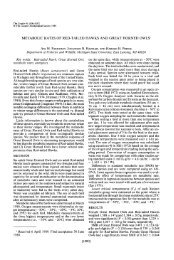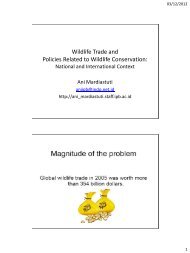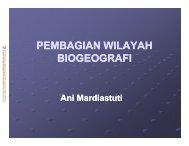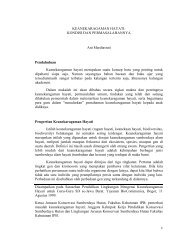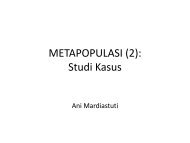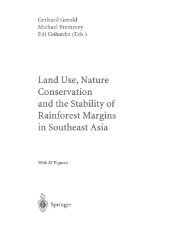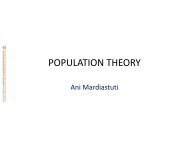HARVEST SUSTAINABILITY OF SULAWESI ... - Comments on
HARVEST SUSTAINABILITY OF SULAWESI ... - Comments on
HARVEST SUSTAINABILITY OF SULAWESI ... - Comments on
- No tags were found...
Create successful ePaper yourself
Turn your PDF publications into a flip-book with our unique Google optimized e-Paper software.
<str<strong>on</strong>g>HARVEST</str<strong>on</strong>g> <str<strong>on</strong>g>SUSTAINABILITY</str<strong>on</strong>g><str<strong>on</strong>g>OF</str<strong>on</strong>g> <str<strong>on</strong>g>SULAWESI</str<strong>on</strong>g> TORTOISE Indotestudo forsteniiIN INDONESIADIRECTOR GENERAL <str<strong>on</strong>g>OF</str<strong>on</strong>g> FOREST PROTECTION AND NATURE CONSERVATIONREPUBLIC <str<strong>on</strong>g>OF</str<strong>on</strong>g> INDONESIAasCITES MANAGEMENT AUTHORITYINDONESIASeptember 2008
<str<strong>on</strong>g>HARVEST</str<strong>on</strong>g> <str<strong>on</strong>g>SUSTAINABILITY</str<strong>on</strong>g> <str<strong>on</strong>g>OF</str<strong>on</strong>g> <str<strong>on</strong>g>SULAWESI</str<strong>on</strong>g> TORTOISE Indotestudo forsteniiIN INDONESIA 1INTRODUCTIONIndotestudo forstenii (Schlegel & Müller 1844) (a.k.a. Forsten’s Tortoise, Sulawesi Tortoise,Sulawesi Forest Turtle; Family Testudinidae, Order Testudines) is an endemic land tortoise of Sulawesi,Ind<strong>on</strong>esia. It is currently recognized as <strong>on</strong>e of three species of the genus Indotestudo. The other twospecies are I. el<strong>on</strong>gata and I. travancorica. The I. forsteni was first described by Schlegel & Müller asTestudo forstenii in 1840 based <strong>on</strong> a specimen from Halmahera Island (World Chel<strong>on</strong>ian Trust 2003,Ivers<strong>on</strong> et al. 2001). Since then, there was a hypotheses whether the I. forstenii was actually an introducespecies of Indotestudo travancorica from India, brought to Sulawesi by early seafarers. A recentphilogenetic study (Ives et al. 2008, Ivers<strong>on</strong> et al. 2001) revealed that the two species are quite distinctand, thus, the hypothesis was rejected.I. forsteni was listed in the CITES Appendix II in 1 July 1975. At the twenty-third meeting of theCITES Animals Committee (AC) held in Geneva <strong>on</strong> 19-24 April 2008 (Agenda Item 8.5), the AC agreedthat I. forstenii was included in the Review of Significant Trade. Currently, this species is not protectedunder Ind<strong>on</strong>esian law although it is listed in Appendix II of CITES and classified as ‘Endangered’ byIUCN categories. This document explains the current situati<strong>on</strong> of the populati<strong>on</strong> and harvest of thisspecies in Ind<strong>on</strong>esia.GEOGRAPHIC DISTRIBUTIONSulawesi is a home of three n<strong>on</strong>-marine chel<strong>on</strong>ians, namely the widespread Malayan Box TurtleCuora amboinensis and two endemic species: the Sulawesi Tortoise Indotestudo forstenii and SulawesiForest Turtle Leucocephal<strong>on</strong> yuw<strong>on</strong>oi (Platt 2006). The I. forstenii have a limited distributi<strong>on</strong> <strong>on</strong> theislands of Halmahera and Sulawesi (Fig. 1), yet specific locality informati<strong>on</strong> exists <strong>on</strong>ly for Sulawesi(Platt et al. 2001, Ivers<strong>on</strong> 1993).Sulawesi is the largest island (227,654 km 2 ) in the Wallacea biogeographic regi<strong>on</strong>, lying betweenthe islands of Borneo to the west and New Guinea to the east. Halmahera is a relatively small island(17,780 km 2 ), located to the east of Sulawesi. Sulawesi’s biota is highly distinctive and has extremelyhigh levels of endemism. Sulawesi’s reptile endemism in particular is high, with 26% of its 117 reptilespecies found nowhere else (Whitten et al. 1987).The documented range of I. forstenii in Sulawesi is localized and significantly restricted.Scientists suggested that the distributi<strong>on</strong>s of this species are parceled within Sulawesi and surroundingislands (Ives 2006, Platt et al. 2001), especially in North and Central Sulawesi, in the western regi<strong>on</strong> ofthe Northern Peninsula of Sulawesi. Known localities in North Sulawesi are Mount Boliahutu and aroundBuol (Platt et al. 2001).In Central Sulawesi, populati<strong>on</strong> of I. forstenii were discovered in Santigi and Morowali Reserve(Platt et al. 2001). Additi<strong>on</strong>ally, Ives (2006) reported that this species can be found in some localities inPalu Valley, Kulawi Valley, Bora Village near Gimpu, as well as al<strong>on</strong>g the western border of Lore LinduNati<strong>on</strong>al Park, suggesting a high possibility of its existence in the park. Another study by Riyanto et al.(2008) also found some specimens in Gunta Hill and Bodi Hill, both located in the Palu Valley. Further,Platt (2006) examined a single living I. forstenii that was being held by a villager in Wanggarasi Timurpending sale to a wildlife trader. This record represents an eastward range extensi<strong>on</strong> of approximately100 km from previously reported populati<strong>on</strong>s <strong>on</strong> Cape Santigi in Central Sulawesi.1 Prepared by Ani Mardiastuti, Senior Fellow of Naha, email: aniipb@indo.net.idNATUREharm<strong>on</strong>y - promoting a balance between development and c<strong>on</strong>servati<strong>on</strong>1
HalmaheraINDONESIASulawesiFig. 1. Distributi<strong>on</strong> of Indotestudo forstenii in Sulawesi Island and probably in Halmahera.As for the populati<strong>on</strong> of I. forstenii in Halmahera Island and other satellite islands of Sulawesi,traders reported that there has been no record <strong>on</strong> harvest of I. forstenii from those areas in several pastdecades. Further research is needed to find out the status of current distributi<strong>on</strong> of this species.Because the full extents of I. forstenii’s distributi<strong>on</strong>s are not clearly known, their status in thewild is uncertain. The lack of informati<strong>on</strong> about this species creates a significant challenge to itsc<strong>on</strong>servati<strong>on</strong>, and c<strong>on</strong>founds effective establishment of management plans (Platt et al. 2001).POPULATIONI. forstenii is c<strong>on</strong>sidered as <strong>on</strong>e of the world’s rarest tortoises. Very few field data <strong>on</strong> scatteredlocal populati<strong>on</strong> surely is not sufficient to make an estimati<strong>on</strong> of the overall populati<strong>on</strong>. Platt et al.(2001) reported that local communities c<strong>on</strong>sidered the tortoise as rare, and a few had ever seen aspecimen.TAXONOMYAs menti<strong>on</strong>ed previously, the genus Indotestudo has three members: Sulawesi Tortoise I.forstenii, El<strong>on</strong>gated tortoise I. el<strong>on</strong>gata and Travancore tortoise I. travancorica. Previously I.travancorica had been c<strong>on</strong>sidered a syn<strong>on</strong>ym of I. forstenii , leading to much c<strong>on</strong>fusi<strong>on</strong> in the literature,as <strong>on</strong>e of the comm<strong>on</strong> names attributed to I. forstenii is the Travancore tortoise (Ivers<strong>on</strong> et al. 2001).Some researchers speculated that the Ind<strong>on</strong>esian populati<strong>on</strong>s of I. forstenii might represent anintroducti<strong>on</strong> of I. travancorica from India. Recently, using a molecular genetic approach to c<strong>on</strong>structphylogenetic relati<strong>on</strong>ships am<strong>on</strong>g the genus Indotestudo, researchers (Ives et al. 2008, Ivers<strong>on</strong> et al.2001) c<strong>on</strong>cluded that three nominal species in the genus Indotestudo are now recognizable: I. el<strong>on</strong>gata2
from the mainland of southern and south-eastern India, I. travancorica from the Western Ghats of southwesternIndia, and I. forstenii from the islands of Sulawesi and Halmahera in eastern Ind<strong>on</strong>esia.Due to the c<strong>on</strong>fusi<strong>on</strong> in the past, the nomenclature of the Sulawesi Tortoise has been changedseveral times: Testudo forstenii (Schlegel & Müller 1844), Geochel<strong>on</strong>e forsteni (Pritchard 1967), andIndotestudo el<strong>on</strong>gata forsteni (Obst. 1985). Turtle Tax<strong>on</strong>omy Working Group (2007) rec<strong>on</strong>firmed thatthe Indotestudo forstenii (Schlegel & Müller 1844) is indeed the agreed Latin name for the SulawesiTortoise.BIOLOGICAL INFORMATIONI. forstenii is a medium sized tortoise. Typically, they are about25 cm l<strong>on</strong>g and 2.5 kg as an adult although, there are larger specimens.Females tend to be wider and more rounded than males. In additi<strong>on</strong>,males have a tail that is noticeably larger as well as l<strong>on</strong>ger than that ofthe female. The tip of the tail is tipped with a small keratinous hook.Males also have a slightly c<strong>on</strong>cave plastr<strong>on</strong> while the plastr<strong>on</strong> of thefemales is completely flat (Auliya 2007, World Chel<strong>on</strong>ian Trust 2005)(Fig. 2)Fig. 2. Plastr<strong>on</strong> of Indotestudo forstenii:c<strong>on</strong>cave plastr<strong>on</strong> in female (top) and flat plastr<strong>on</strong> in male (bottom).Photo: Ani Mardiasuti.Little is known about the habitat requirements of I. forstenii in the wild. This species is primarilya damp forest species though it can be found in dry areas as well (World Chel<strong>on</strong>ian Trust 2005) (Fig. 3).One specimens of Ives (2006) was found near a stream <strong>on</strong> the border of Lore Lindu Nati<strong>on</strong>al Park inKulawi (km marker 71 south of Palu). The capture locati<strong>on</strong> was 5m upstream from the main road in a plotof land cleared for a mixed cocoa, banana and palm plantati<strong>on</strong>.I. forstenii shell was found am<strong>on</strong>g rock outcrops in sec<strong>on</strong>d-growth forests growing <strong>on</strong> the steephillsides of Cape Santigi. Likewise, local hunters in this area reportedly found tortoises by searchingcrevices and rock overhangs (Platt et al. 2001). Ives (2006) found I. forstenii am<strong>on</strong>g xerophytic scrubvegetati<strong>on</strong> in the dry Palu Valley, while Platt (2006) reported that villagers found the tortoise insec<strong>on</strong>dary forest <strong>on</strong> the edge of an agricultural field after being alerted by their dog.The tortoise is mainly crepuscular, active in the twilight hours before dawn or just after sunset. Itslarge eyes are well adapted to low light levels. The species has an omnivorous diet in the wild c<strong>on</strong>sistingof fruits, leafy greens, worms, slugs and carri<strong>on</strong> if available (World Chel<strong>on</strong>ian Trust 2005).Fig. 3. Indotestudo forstenii found in its natural habitatnear Palu, Central Sulawesi.Photo by Awal Riyanto.3
A lack of shell damage suggested that predators were not resp<strong>on</strong>sible for a natural mortality. Thetortoises may have succumbed from desiccati<strong>on</strong> or starvati<strong>on</strong> during the severe, prol<strong>on</strong>ged El-Niñorelateddroughts of 1997 and 1998. Wildfires may be resp<strong>on</strong>sible for c<strong>on</strong>siderable mortality am<strong>on</strong>g I.forstenii populati<strong>on</strong>s in northern Sulawesi (Platt et al. 2001).Iskandar (2000) reported that clutch size of wild I. forstenii is 2-9 eggs. The eggs are oval shape,measuring 45-50 x 36-40 mm. Limited reproductive observati<strong>on</strong>s in captivity suggest that females mayproduce clutches 3 times a year (Ives 2006) and the females have been recorded to lay a clutch of 1-4eggs in an excavated nest in early spring (World Chel<strong>on</strong>ian Trust 2005).<str<strong>on</strong>g>HARVEST</str<strong>on</strong>g> AND TRADEDue to the tax<strong>on</strong>omic dispute in the past, in the early 1990s, nearly all specimens of the genusIndotestudo imported into the United States were identified as I. el<strong>on</strong>gata or I. travancorica. Therefore,the data may be not reflecting the actual export (World Chel<strong>on</strong>ian Trust 2005).Based <strong>on</strong> the data of CITES Secretariat, Compt<strong>on</strong> (2000) noted that between 1985 and 1998, I.forstenii ranked the third in term of the number of turtle specimens exported from Southeast Asia, totaling5,263 individuals. Samedi & Iskandar (2000) also reported that the populati<strong>on</strong> number of this species inthe wild have declined c<strong>on</strong>siderably.C<strong>on</strong>sidering the restricted distributi<strong>on</strong> of this species, number of individuals that can be harvestedis also limited. Interviews with traders in Jakarta revealed that they have been receiving shipment of I.forstenii mostly from an area at the boundary of North Sulawesi and Central Sulawesi Provinces. Nospecific geographic locati<strong>on</strong> menti<strong>on</strong>ed, as the traders received shipment from collectors in cities ofSulawesi, not from hunters who directly capture the species. N<strong>on</strong>e of the traders receive I. forstenii fromHalmahera or other small satellite islands of Sulawesi.Further field observati<strong>on</strong> need to be c<strong>on</strong>ducted to find out whether I. forstenii still exists inHalmahera Island. According to the traders, the absence of I. forstenii shipment from Halmahera and itssurrounding islands probably due to the social unrest that has been going <strong>on</strong> for years in that area.Another reas<strong>on</strong> is because Halmahera Island is relatively far from Menado, the closets city fromHalmahera where collectors are located, and thus transportati<strong>on</strong> cost is too high.From their natural habitat in northern and central Sulawesi, I. forstenii are collected by searchingcrevices and rock overhangs (Platt et al. 2001). Usually hunters capture the I. forstenii with the help ofhunting dogs. Once the dog has discovered a tortoise, the hunter will scour the area for additi<strong>on</strong>alindividuals, often discovering nests in the immediate vicinity areas (Ives 2006). Observati<strong>on</strong> in holdingfacilities in Palu by Ives (2006) revealed that harvest have been c<strong>on</strong>ducted for both age class (juvenile andadult), and males are likely to be easily caught, maybe due to the fact that females are more sedentary andless likely to be caught roaming out in the open.Almost all Ind<strong>on</strong>esian turtles and tortoises are characterized by a dull, greenish or brownishcarapace, to enable them blend in the natural habitat in order to avoid predati<strong>on</strong>. Unlike other Ind<strong>on</strong>esiantortoise species, I. forstenii has a combinati<strong>on</strong> of a cream and black color, making this species unique inan internati<strong>on</strong>al pet market. A recent survey of pet markets in Jakarta by Sinaga (2008) revealed thatthere was a small number of I. forstenii found <strong>on</strong> display in domestic market or via cybermarket, althoughthis species is not c<strong>on</strong>sidered as popular pet because the Ind<strong>on</strong>esian hobbyist prefers more colorful exoticturtles or tortoises. Thus, domestic demand for this species is low compare to export demand.Export destinati<strong>on</strong>s of I. forstenii are mostly USA (c. 75%) and Japan (c. 25%). The popular sizeof exported individuals is juveniles of about 10-15 cm in carapace length. Younger individuals might notsurvive l<strong>on</strong>g transportati<strong>on</strong> and acclimatizati<strong>on</strong> period in the destinati<strong>on</strong> country.Populati<strong>on</strong> number in the wild derived from harvest data is difficult to estimate. This is due tothe fact that in the last ten years or so the quota of I. forstenii has been set at low figures. Exporters inJakarta admit that from time to time collectors in Sulawesi are still offered individuals of I. forsteniii byhunters. However, due to the limited number of quota for each exporter (i.e., 270 heads for 6 exporters),4
the exporters have to refuse the offer. As a result, many individuals of I. forstenii can be found in thecollectors’ holding compound in Sulawesi. A few maybe still can be sold in the domestic market.<str<strong>on</strong>g>SUSTAINABILITY</str<strong>on</strong>g> <str<strong>on</strong>g>OF</str<strong>on</strong>g> TRADEA. Quota and Its Related Regulati<strong>on</strong>Ind<strong>on</strong>esia has been a Party to CITES since 1978. As I. forstenii is listed in the CITES AppendixII since 1975, the trade of this species is regulated accordingly. A quota number is set by the ScientificAuthority (Ind<strong>on</strong>esian Institute of Sciences) as the basis of harvest level.In 1993, the quota of this species was set at 1,500 heads. Aware of the naturally restrictedgeographical area, coupled with low reproductive rate and the decreasing populati<strong>on</strong> in the wild due toharvest and agriculture expansi<strong>on</strong>, the CITES Authority of Ind<strong>on</strong>esia has been drastically reduced thequota number. Quota for 2000 to 2008 was set <strong>on</strong>ly about 450 – 500 heads and in 2008 the quota wasfurther reduced as low as 270 heads (Table 1).Table 1. Quota and actual export of Indotestudo forstenii from Ind<strong>on</strong>esia.(Source: Directorate General of Forest Protecti<strong>on</strong> and Nature C<strong>on</strong>servati<strong>on</strong>, Ministry of Forestry).YearQuota(heads)Actual Export(heads)2000 450 4352001 450 4502002 400 3982003 500 4912004 475 4742005 475 4752006 475 4752007 475 4702008 270 165**up to mid SeptemberBy lowering the quota number, it was expected that the populati<strong>on</strong> of I. forstenii in the wild willbe recovered. As for now, the available data is not sufficient to set a more exact sustainable harvest level.Further field survey to reveal the distributi<strong>on</strong> and populati<strong>on</strong> estimati<strong>on</strong> of I. forstenii in the remainingareas, as well as other life history is planned to be c<strong>on</strong>ducted by the Scientific Authority.B. Traders and Their ExportsTraders of reptiles and amphibian in Ind<strong>on</strong>esia have created an associati<strong>on</strong> called IRATA(Ind<strong>on</strong>esian Reptile and Amphibian Traders Associati<strong>on</strong>) since 1991. Initially the members c<strong>on</strong>sisted <strong>on</strong>traders in tannery and finished product. Later <strong>on</strong> in 1995 pet traders joint the associati<strong>on</strong>. CurrentlyIRATA’s membership can be categorized as live reptiles (pets), tannery, and finished product.As for now, IRATA has 18 pet exporter members (IRATA 2008), of which 6 are listed asexporter of I. forstenii this year. The number of export companies has been reduced during the past threeyears due to the decreasing quota number. The export quota was divided am<strong>on</strong>g these members byIRATA, based <strong>on</strong> criteria set by the CITES Authority. Export of I. forstenii by all exporting companies ispresented in Table 2.5
Table 2. Export of Indotestudo forstenii by all companies in 2006-2008 andexport quota for each company in 2008.(Source: Directorate General of Forest Protecti<strong>on</strong> and Nature C<strong>on</strong>servati<strong>on</strong>, Ministry of Forestry).No. Company Name Year Export Quota 20082006 2007 2008* (heads)1 CV Terraria Ind<strong>on</strong>esia 106 108 54 932 PT Mega Citrindo Ind<strong>on</strong>esia 168 138 54 933 PT Alam Nusantara Jayatama 55 58 17 294 CV Penta Exomania 36 19 11 195 CV Silva Patria Lestari 0 19 11 196 FA Hasco 0 22 9 167 CV Prestasi 50 53 0 08 CV Herpafauna 50 53 0 09 CV Leo Jaya 10 0 0 0Total 269*up to mid SeptemberBreeding operati<strong>on</strong>s of I. forstenii in Ind<strong>on</strong>esia have been started since 1996 by CV Pasundan.Currently there are 4 companies listed to breed this species (i.e., PT Alam Nusantara Jayatama, CVPrestasi, CV Pasundan, and CV Terraria Ind<strong>on</strong>esia) (Fig. 4). Data <strong>on</strong> parental stock and the firstgenerati<strong>on</strong> of each company is presented in Table 3, while data <strong>on</strong> export from breeding operati<strong>on</strong> islisted in Table 4.Fig. 4. Breeding operati<strong>on</strong> of Indotestudo forstenii by CV Prestasi.Photos by Suwita Widjaja.6
Table 3. Breeding stocks of Indotestudo forstenii for captive breeding operati<strong>on</strong>s.(Source: Directorate General of Forest Protecti<strong>on</strong> and Nature C<strong>on</strong>servati<strong>on</strong>, Ministry of Forestry).Year Generati<strong>on</strong>PT Alam NusantaraJayatamaCV Prestasi CV Pasundan CV TerrariaInd<strong>on</strong>esiaMale Female Male Female Male Female Male Female2006 F0 2 4 3 7 27 81 9 9F1 1 2 5 10 114 121 0 02007 F0 2 4 3 7 27 81 9 9F1 1 2 14 28 27 30 0 02008 F0 2 4 3 7 27 81 9 9F1 5 9 14 28 27 30 0 0Table 4. The number exported specimens of Indotestudo forstenii from Ind<strong>on</strong>esia,originated from breeding operati<strong>on</strong>s.(Source: Directorate General of Forest Protecti<strong>on</strong> and Nature C<strong>on</strong>servati<strong>on</strong>, Ministry of Forestry).No Company Export (head) Year of Export1 PT Alam Nusantara Jayatama 10 20082 CV Pasundan 20 2006178 20073 CV Prestasi 0 -4 CV Terraria Ind<strong>on</strong>esia 0 -CONCLUDING REMARKSI. forstenii is a rare and endemic tortoise, having a very narrow distributi<strong>on</strong> in Sulawesi Island.Some field research have been c<strong>on</strong>ducted, triggered by the uniqueness of this species in term ofgeographical distributi<strong>on</strong> within the Wallacean biogoegraphy regi<strong>on</strong> and tax<strong>on</strong>omy.The species is very popular as pet in the internati<strong>on</strong>al market, although a few specimen is alsoreported has been used for c<strong>on</strong>sumpti<strong>on</strong>. The export quota for I. forstenii has been set at low and safenumber of 270 heads, despite the high internati<strong>on</strong>al demand of this species for pet. Further researchtoward estimati<strong>on</strong> number and sustainable harvest level will c<strong>on</strong>tinue to ensure the sustainability of thisspecies in its natural habitat. In additi<strong>on</strong>, captive breeding of this species has been started by somecompanies, and will be intensified and extended to others in the future.7
ACKNOWLEDGMENTS. The author wishes to thank (in alphabetical order): Andre van Meer, E. Emy Setyo Novitasari, BennySoetanto, Danny Gunalen, George Tatang Saputra, Hellen Kurniati, Herianto, Kris Heryanto, Mumpuni, Suwita Widjaja,Syarifuddin, and all staff of Directorate of Biodiversity C<strong>on</strong>servati<strong>on</strong> – Ministry of Forestry for sharing their informati<strong>on</strong> andknowledge during the preparati<strong>on</strong> of this document.REFERENCESAuliya, M. 2007. An identificati<strong>on</strong> guide to the tortoise and freshwater turtles of Bunei Daussalam,Ind<strong>on</strong>esia, Malaysia, Papua New Guinea, Philippines, Singapore and Timor Leste. TRAFFICSoutheast Asia. Petaling Jaya, Malaysia.Compt<strong>on</strong>, J. 2000. An overview of Asian turtle trade. Chel<strong>on</strong>ian Research M<strong>on</strong>ographs 2:24-29.IRATA. 2008. Biodiversity c<strong>on</strong>servati<strong>on</strong> and sustainable use. IRATA. Jakarta.Iskandar, D.T. 2000. Kura-kura dan buaya Ind<strong>on</strong>esia dan Papua Guini. Institut Teknologi Bandung.Bandung, Ind<strong>on</strong>esia.Ivers<strong>on</strong>, J.B.; P. Q. Spinks, H. B. Shaffer, W. P. McCord & I. Das. 2001. Phylogenetic relati<strong>on</strong>shipsam<strong>on</strong>g the Asian tortoises of the genus Indotestudo (Reptilia: Testudines: Testudinidae).Hamadryad 26(2): 272 – 275.Ives, I. 2006. C<strong>on</strong>servati<strong>on</strong> of Sulawesi’s two endemic Chel<strong>on</strong>ians, Leucocephal<strong>on</strong> yuw<strong>on</strong>oi andIndotestudo forstenii: An investigati<strong>on</strong> into in-situ and ex-situ c<strong>on</strong>servati<strong>on</strong> c<strong>on</strong>cerns. Master’sThesis. Department of Envir<strong>on</strong>mental Studies, Antioch University. New EnglandIves, I; P. Q. Spinks & H.B. Shaffer. 2008. Morphological and genetic variati<strong>on</strong> in the endangeredSulawesi tortoise Indotestudo forstenii : Evidence of distinct lineages? C<strong>on</strong>servati<strong>on</strong> Genetics9(3):709-713. Abstract Only.Platt, S.G. 2006. A Survey to determine the c<strong>on</strong>servati<strong>on</strong> status of endemic Chel<strong>on</strong>ians in NorthernSulawesi, Ind<strong>on</strong>esia. Report to Wildlife C<strong>on</strong>servati<strong>on</strong> Society. Retrieved <strong>on</strong> 4 September fromwww.asianturtlenetwork.org/library/reports_publicati<strong>on</strong>s.htm.Platt, S.G.; R.J. Lee & M.W. Klemens. 2001. Notes <strong>on</strong> the distributi<strong>on</strong>, life history, and exploitati<strong>on</strong> ofturtles in Sulawesi, Ind<strong>on</strong>esia, with emphasis <strong>on</strong> Indotestudo forstenii and Leucocephal<strong>on</strong>yuw<strong>on</strong>oi. Chel<strong>on</strong>ian C<strong>on</strong>servati<strong>on</strong> and Biology 4(1):154-159.Riyanto, A.; A. Farajallah & J. Aris<strong>on</strong>a. 2008. The endangered Sulawesi Tortoise (Indotestudoforstenii): Behavior, habitat, populati<strong>on</strong> in the wild and the harvest level. Sec<strong>on</strong>d Interim Reportsubmitted to Turtle C<strong>on</strong>servati<strong>on</strong> Fund and C<strong>on</strong>servati<strong>on</strong> Internati<strong>on</strong>al. Retrieved <strong>on</strong> 4September fromwww.asianturtlenetwork.org/library/.../The_Endangered_Sulawesi_Tortoise_Indotestudo_forstenii_Report_by_Riyantol_etal_2008.pdfSamedi & D.T. Iskandar. 2000. Freshwater turtle and tortoise c<strong>on</strong>servati<strong>on</strong> and utilizati<strong>on</strong> in Ind<strong>on</strong>esia.Chel<strong>on</strong>ian Research M<strong>on</strong>ograph 2:106-111.Sinaga, N. 2008. Perdagangan kura-kura darat dan kura-kura air tawar di Jakarta. Master’s Thesis.Faculty of Forestry. Bogor Agriculture University. Bogor.Turtle Tax<strong>on</strong>omy Working Group. 2007. An annotated list of modern turtle terminal taxa withcomments <strong>on</strong> areas of tax<strong>on</strong>omic instability and recent change. Chel<strong>on</strong>ian Research M<strong>on</strong>ographs4:173–199.Whitten, A.J.; M. Mustafa & G.S. Henders<strong>on</strong>. 1987. The ecology of Sulawesi. Gadjah University Press.Yogyakarta, Ind<strong>on</strong>esia.World Chel<strong>on</strong>ian Trust. 2005. Forsten's Tortoise - Indotestudo forstenii (Schlegel & Müller 1844).Retrieved <strong>on</strong> 4 September 2008 from www.chel<strong>on</strong>ia.org/Articles/PDFS/Forsten.pdf.8




